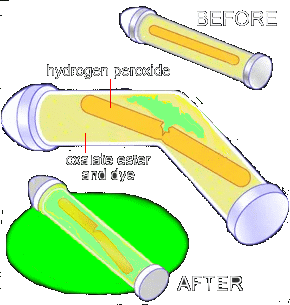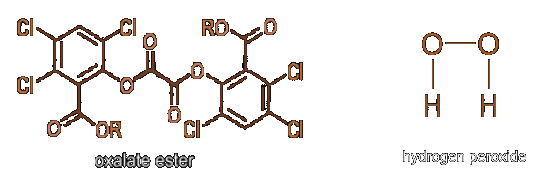  A glow stick consists of a glass vial containing a liquid chemical that is sealed inside a larger plastic tube that contains another solution. When you bend the plastic tube, the glass vial inside breaks and the two solutions mix together. The resulting chemical reaction causes a fluorescent dye to emit light.
A glow stick consists of a glass vial containing a liquid chemical that is sealed inside a larger plastic tube that contains another solution. When you bend the plastic tube, the glass vial inside breaks and the two solutions mix together. The resulting chemical reaction causes a fluorescent dye to emit light.Light is a form of energy, which can be emitted in a variety of ways. These ways include:
A glow stick uses a chemical reaction to excite the atoms. This chemical reaction happens when several chemical compounds are allowed to mix. Compounds are substances made up of atoms of different elements, bonded together. When you combine two or more compounds, the various atoms may rearrange themselves to form new compounds. This reaction will cause either a release of energy or absorption of energy. The reaction between the different compounds in a glow stick causes a substantial release of light energy. Atoms in the materials are excited, causing electrons to rise to a higher energy level and then return to their normal levels. When the electrons return to their normal levels, they release energy as light. This process is called chemiluminescence. Light sticks come in a variety of colours. The color of the light is determined by the chemical makeup of the fluorescent dye in the stick.  A typical glow stick holds a hydrogen peroxide solution, a solution containing an oxalate ester and a fluorescent dye. A typical glow stick holds a hydrogen peroxide solution, a solution containing an oxalate ester and a fluorescent dye. Before activating the stick, the two solutions are kept in separate chambers. The oxalate ester and dye solution fills most of the plastic tube itself. The hydrogen peroxide solution, called the activator, is contained in a small, fragile glass vial in the middle of the stick. When you bend the plastic stick, the glass vial inside snaps open, and the two solutions mix. The chemicals react with one another, and the atoms begin emitting light. Here are the details of the reaction if you're interested: 
If you want to preserve your light stick for the next day, put it in the freezer — it won't stop the process, but it will drag out the reaction for a long time. Glow sticks are just one example of an important natural phenomenon - luminescence. Luminescence is any emission of light that oisn't caused by heat. Luminescence is used in neon lights and glow-in-the-dark toys. It's also the principle that lights up a firefly. The military also uses longer-lasting glow sticks. In fact, the government market for glow sticks in the U.S. is about $35 million a year, compared with about $40 million for the novelty market. |